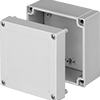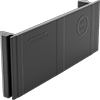Filter by
Cover Closure Method
Environment
Enclosure Rating
Cover Material
Inside Height
Cover Clarity
Certification
Export Control Classification Number (ECCN)
DFARS Specialty Metals
About Electrical Enclosures
Select the right electrical enclosure for your environment and the accessories you'll need to get it mounted and connected.
Electrical Enclosures

















































































